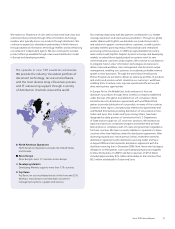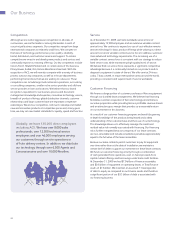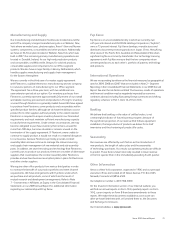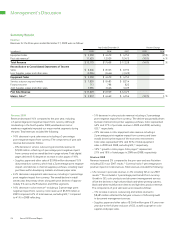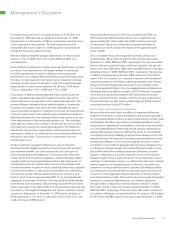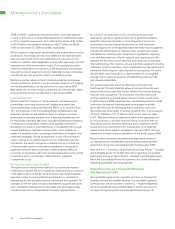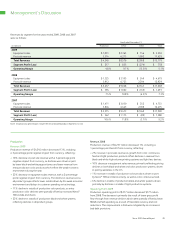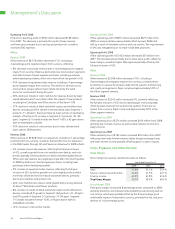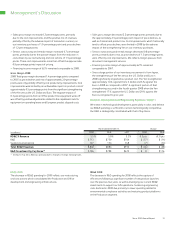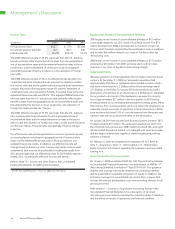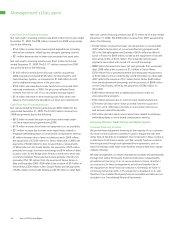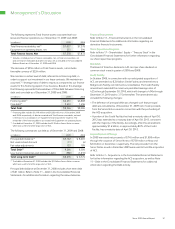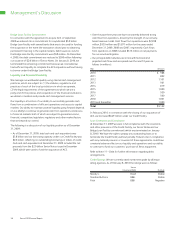Xerox 2009 Annual Report Download - page 30
Download and view the complete annual report
Please find page 30 of the 2009 Xerox annual report below. You can navigate through the pages in the report by either clicking on the pages listed below, or by using the keyword search tool below to find specific information within the annual report.
28 Xerox 2009 Annual Report
Management’s Discussion
As a result of our acquisition of GIS, as well as other prior-year
acquisitions, we have a significant amount of goodwill. Goodwill is
tested for impairment annually or more frequently if an event or
circumstance indicates that an impairment loss may have been
incurred. Application of the goodwill impairment test requires judgment,
including the identification of reporting units, assignment of assets
and liabilities to reporting units, assignment of goodwill to reporting
units and determination of the fair value of each reporting unit. We
estimate the fair value of each reporting unit using a discounted cash
flow methodology. This requires us to use significant judgment including
estimation of future cash flows, which is dependent on internal forecasts,
estimation of the long-term rate of growth for our business, the useful
life over which cash flows will occur, determination of our weighted
average cost of capital for purposes of establishing a discount rate
and relevant market data.
Our annual impairment test of goodwill was performed in the
fourth quarter. The estimated fair values of our reporting units were
based on discounted cash flow models derived from internal earnings
forecasts and assumptions. The assumptions and estimates used
in those valuations incorporated the current economic environment.
In performing our 2009 impairment test, the following were the overall
composite assumptions regarding revenue and expense growth,
which were the basis for estimating future cash flows used in the
discounted cash flow model: 1) revenue growth 2–4%; 2) gross margin
39–40%; 3) RD&E 4–5%; 4) SAG 24–25%; and 5) return on sales
8–9%. We believe these estimated assumptions are appropriate for
our circumstances, in line with historical results, consistent with our
forecasted long-term business model and give consideration to the
current economic environment. Our forecast does not include the
impact of the ACS acquisition completed in February 2010, since our
impairment test was limited to goodwill as of the fourth quarter 2009.
Based on these valuations, we determined that the fair values of
our reporting units exceeded their carrying values and no goodwill
impairment charge was required during the fourth quarter 2009.
Refer to Note 1 – Summary of Significant Accounting Policies – “Goodwill
and Intangible Assets” for further information regarding our goodwill
impairment testing, as well as Note 8 – Goodwill and Intangible Assets,
Net in the Consolidated Financial Statements for further information
regarding goodwill by operating segment.
Operations Review of Segment Revenue
and Operating Profit
Our reportable segments are consistent with how we manage the
business and view the markets we serve. Our reportable segments
are Production, Office and Other. See Note 2 – Segment Reporting
in the Consolidated Financial Statements for further discussion on
our segment operating revenues and segment operating profit.
2008 and 2007, respectively, that did not affect income tax expense
in total, as there was a corresponding adjustment to deferred tax assets
or other comprehensive income. Gross deferred tax assets of $3.7 billion
and $3.8 billion had valuation allowances of $672 million and $628
million at December 31, 2009 and 2008, respectively.
We are subject to ongoing tax examinations and assessments in various
jurisdictions. Accordingly, we may incur additional tax expense based
upon our assessment of the more-likely-than-not outcomes of such
matters. In addition, when applicable, we adjust the previously recorded
tax expense to reflect examination results. Our ongoing assessments
of the more-likely-than-not outcomes of the examinations and related
tax positions require judgment and can materially increase or decrease
our effective tax rate, as well as impact our operating results.
We file income tax returns in the U.S. Federal jurisdiction and various
foreign jurisdictions. In the U.S. we are no longer subject to U.S. Federal
income tax examinations by tax authorities for years before 2007.
With respect to our major foreign jurisdictions, we are no longer subject
to tax examinations by tax authorities for years before 2000.
LegalContingencies
We are involved in a variety of claims, lawsuits, investigations and
proceedings concerning securities law, intellectual property law,
environmental law, employment law and ERISA, as discussed in Note
16 – Contingencies in the Consolidated Financial Statements. We
determine whether an estimated loss from a contingency should
be accrued by assessing whether a loss is deemed probable and can
be reasonably estimated. We assess our potential liability by analyzing
our litigation and regulatory matters using available information.
We develop our views on estimated losses in consultation with outside
counsel handling our defense in these matters, which involves an
analysis of potential results, assuming a combination of litigation and
settlement strategies. Should developments in any of these matters
cause a change in our determination as to an unfavorable outcome
and result in the need to recognize a material accrual, or should any
of these matters result in a final adverse judgment or be settled for
significant amounts, they could have a material adverse effect on
our results of operations, cash flows and financial position in the period
or periods in which such change in determination, judgment
or settlement occurs.
BusinessCombinationsandGoodwill
The application of the purchase method of accounting for business
combinations requires the use of significant estimates and assumptions
in the determination of the fair value of assets acquired and liabilities
assumed in order to properly allocate purchase price consideration
between assets that are depreciated and amortized from goodwill. Our
estimates of the fair values of assets and liabilities acquired are based
upon assumptions believed to be reasonable and, when appropriate,
include assistance from independent third-party appraisal firms.



